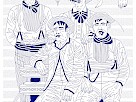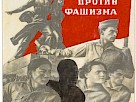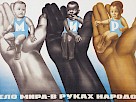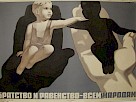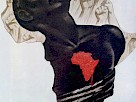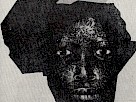Soviet Lives of Uncle Tom and Wayland Rudd Collection
Africans and African-Americans in Soviet and Russian culture
Russian American Cultural Center (RACC) presents an exhibition of sixteen drawings and collages by Dmitry Borshch, "Soviet Lives of Uncle Tom", in which the artist illustrates not the book "Uncle Tom’s Cabin" but its varied lives in Russia, from 1852 to post-Soviet times. "Having read one of many Soviet children's editions of the book as a child and later becoming impressed by its global success, I have never attempted to illustrate it traditionally, in the manner of Hammatt Billings, its first illustrator, and those who followed him," says Dmitry. "In this exhibition I illustrate the handling of the book by Russian censors, editors, preface and afterword writers, publishers. Although it was published in Russia about three years before statutory abolition of serfdom, and already then manipulated for the Russian government's benefit, I focus in the exhibition on Soviet manipulations of the classic, performed by those who were living in Soviet bondage upon a novel about bondage in America. Excerpts from their prefaces to the book, afterwords, and translations are rendered calligraphically: Stowe's English and translators' Russian passages are organized into parallel columns on the same pink sheets, which helps the viewer to notice politicized manipulations of the translators and their censor-editors. All these pictures were made recently but are informed by thirty-five-year-old memories: like you [the exhibition's curator] I still remember the late Soviet treatment of this novel, when it was employed widely for anti-capitalist, anti-American propaganda, extolment of USSR as the righteous opposite of USA, advancement of Soviet hegemonic goals," concludes the artist.
Our exhibition will take place during the African American History Month, ending with a talk by Dmitry on the relationship between Russian serfs and American slaves, and the uses of literature for anti-Western purposes in Russia now. Dr. Khidekel curated "Soviet Lives of Uncle Tom", which is supported by funds from New York State Council on the Arts, New York City Department of Cultural Affairs in partnership with the City Council, and Materials for the Arts.
For more than 10 years Dmitry Borshch has collaborated with Russian American Cultural Center. It was founded in 1998 by Dr. Regina Khidekel and earned its 501(c)(3) tax-exempt status in 1999. RACC aims to provide permanent cultural representation to more than 700,000 Russian-speaking residents of New York. The center has adopted and broadened the strategy of organizations like No Longer Empty, http://www.nolongerempty.org/ which invigorate neighborhoods by mounting exhibitions in their unutilized or temporarily underutilized spaces. Visitors coalesce around a space where art may have never been exhibited before.
-------------------------------------------------------------
The Wayland Rudd Collection is a collaborative project organized by Yevgeniy Fiks that focuses on the representation of Africans and African-Americans in Soviet visual culture. A point of departure for this project is Fiks’ collection of over 200 Soviet images (paintings, movie stills, posters, graphics, etc.) of Africans and African-Americans spanning from the 1920s to the 1980s. Fiks invited contemporary artists and academics to select one or more images from this collection and to respond to it, either via artwork or other forms. Some of the participants chose to react to Fiks’ invitation with artworks that were already premade, but which reflect on the issues that are raised in Fiks’ original call for participation.
Wayland Rudd was an American actor who began performing in the Hedgerow Theater in Rose Valley, Pennsylvania under the directorship of Jasper Deeter. Rudd first received critical acclaim for his performance in Eugene O’Neill’s “Emperor Jones.” Frustrated over racism in the entertainment industry, Rudd moved to the Soviet Union in 1932 where he began a successful career in Soviet Theater and Film including work with the famed Russian Director Vsevolod Meyerhold. He later received a degree from the Theatrical Art Institute in Moscow and worked at the Stanislavsky Opera and Drama Theater. Rudd died in Moscow in 1952.
During Wayland Rudd’s twenty year-long career in the Soviet Union, he appeared in numerous films, theatrical performances, and plays. He was also used as a model for paintings, drawings, and propaganda posters and, in many respects, defined the image of the “Negro” for generations of Soviet people. Although only a small section of the assembled images in The Wayland Rudd Collection are of Wayland Rudd, the project is given his name to commemorate this American-Soviet actor’s personal story as a case in point of the complex intersection of 20th century American-Soviet narrative.
The historical Soviet images present a very complex and often contradictory mapping of the intersection of race and Communism in the Soviet context. They present this issue as unresolved, revealing the Soviet legacy on race as a mix bag of internationalism, solidarity, humanism, Communist ideals as well as exoticization, otherness, racist stereotyping, and hypocrisy.
Artists in the exhibition: Ivan Brazhkin, Michael Paul Britto, Suzanne Broughel, Maria Buyondo, Zachary Fabri, Joy Garnett, Alexey Katalkin, Kara Lynch, Nontsikelelo Mutiti, Nikolay Oleynikov and Arkadiy Kots Band, Natalia Pershina-Yakimanskaya (Gluklya), Jenny Polak, Dread Scott, and Haim Sokol.
